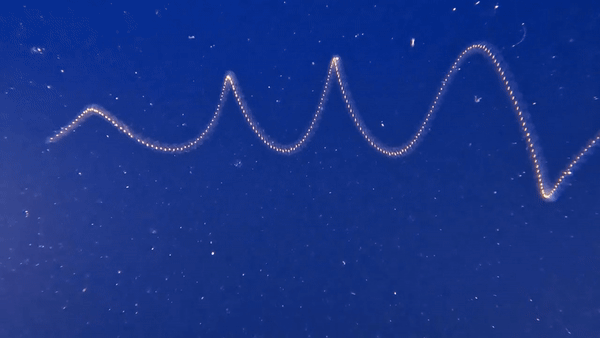Jelly-like sea creatures called salps could inspire new underwater robots, study finds

Video shows graceful migration of salps swimming off coast of Hawaii
The video shows colonies of salps swimming in the Pacific Ocean off the coast of Kailua-Kona, Hawaii. Salps use coordinated jet propulsion to swim. Video Courtesy: Kelly Sutherland/University of Oregon
One of the largest migrations on Earth happens in the dark ocean every night, as tiny jelly-like organisms work together to emerge from the deep sea to the surface. Biologists think the ocean migration could inspire future robotic technology.
Researchers published their findings in the journal Science Advances earlier this month, detailing their underwater observations of the “graceful migration” of the macroplankton known as salps, which swim through the ocean by coordinated jet propulsion.
FLORIDA, CARIBBEAN CORAL REEFS SHOWING SIGNS OF ANOTHER MASS BLEACHING AMID EARLY HEAT STRESS
Oregon Institute of Marine Biology associate professor Kelly Sutherland led the team that developed 3D cameras to study these creatures underwater off the coast of Kailua-Kona, Hawaii.
“The largest migration on the planet happens every single night: the vertical migration of planktonic organisms from the deep sea to the surface,” Sutherland said. “They’re running a marathon every day using novel fluid mechanics. These organisms can be platforms for inspiration on how to build robots that efficiently traverse the deep sea.”
According to the paper, these macroplankton live far offshore and can operate alone or as colonies. A colony can include hundreds of salps that form chains several feet long and travel the ocean using a unique swimming technique.
WATCH: BRIGHT BLUE FIREBALL FLASHES ACROSS SKY IN SPAIN, PORTUGAL
Sutherland said helical swimming is not a new concept in biology, but salps’ motion is different because they move through jet propulsion.
A colony of salps helical swimming in the ocean off the coast of Kailua-Kona, Hawaii. Salps are gelatinous macroplankton that can operate in colonies interlocked in a chain. Colonies swim via coordinated jet propulsion. Shorter colonies spin on a single axis as they swim whereas longer colonies swim in a corkscrew shape. (Kelly Sutherland)
Salps contract muscle bands to pump water from one side of the body and push it out the other end to create thrust. Like a spacecraft firing thrusters to move in space, these tiny creatures propel themselves through water.
Sutherland and the others on the research team witnessed this graceful movement through water in the Pacific Ocean.
A colony of salps swimming in the ocean off the coast of Kailua-Kona, Hawaii. Salps are gelatinous macroplankton that can operate in colonies interlocked in a chain. (Brad Gemmell)
“They have multiple units pulsing at different times, creating a whole chain that moves very smoothly. It’s a really beautiful way of moving,” she said in a news release.
According to the researchers, studying salps could help develop microrobots that move underwater silently using a similar form of propulsion.



